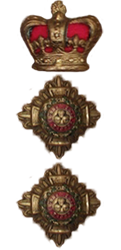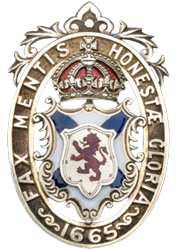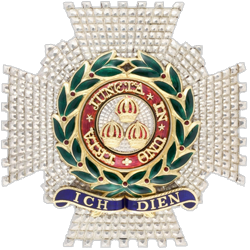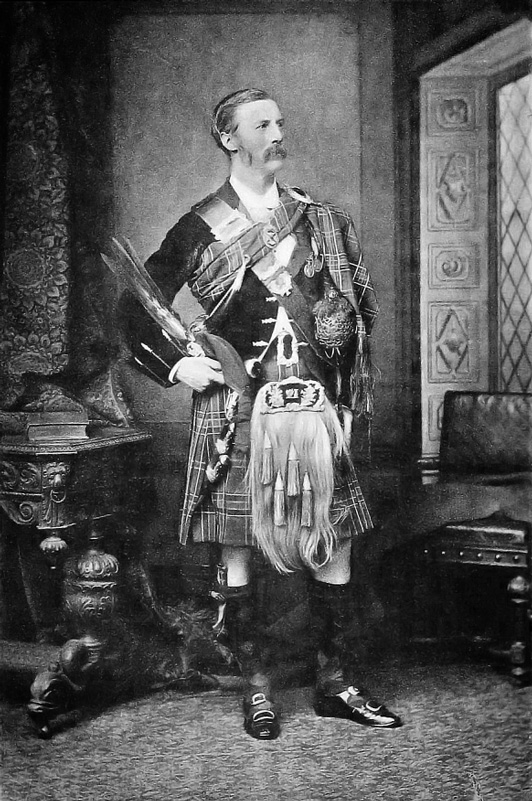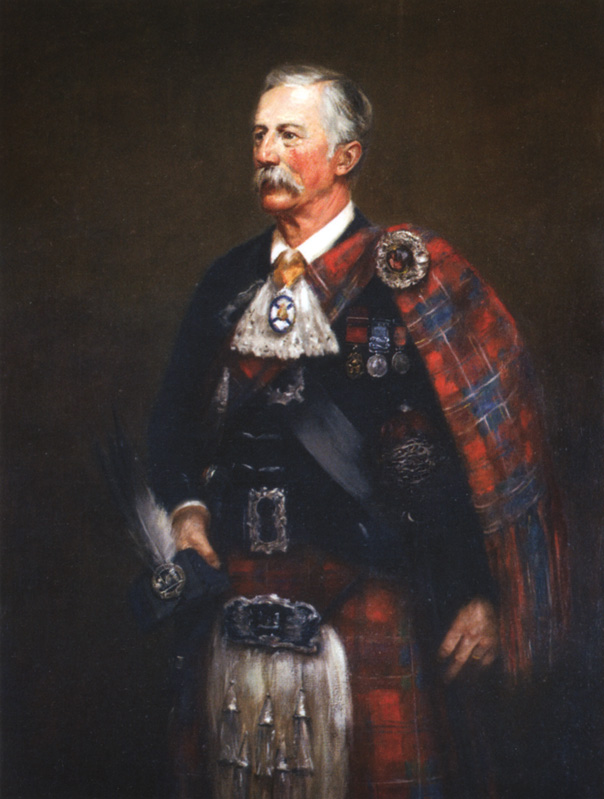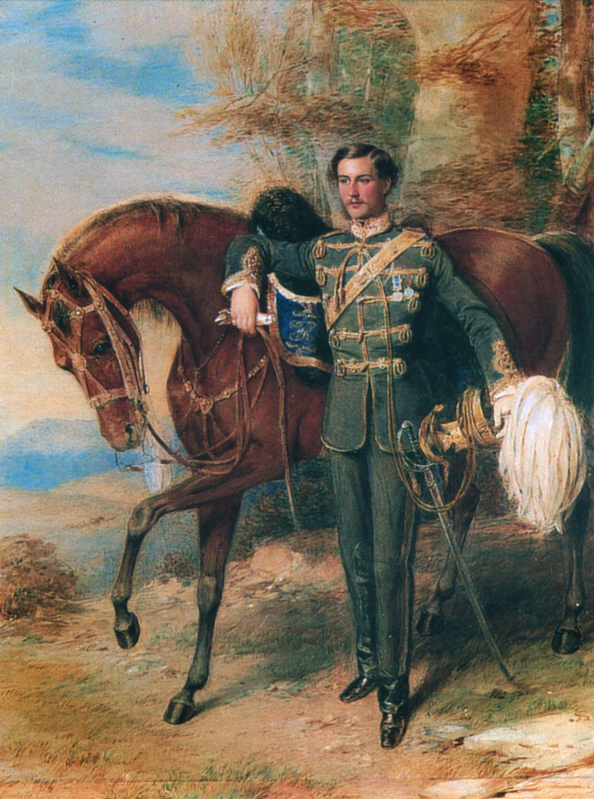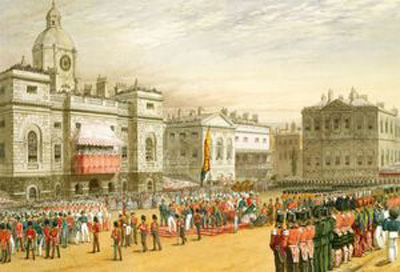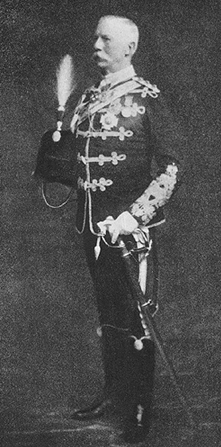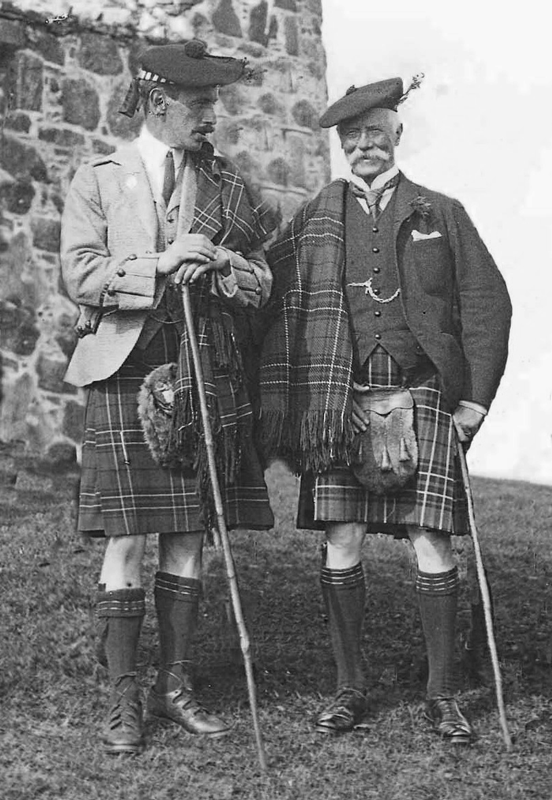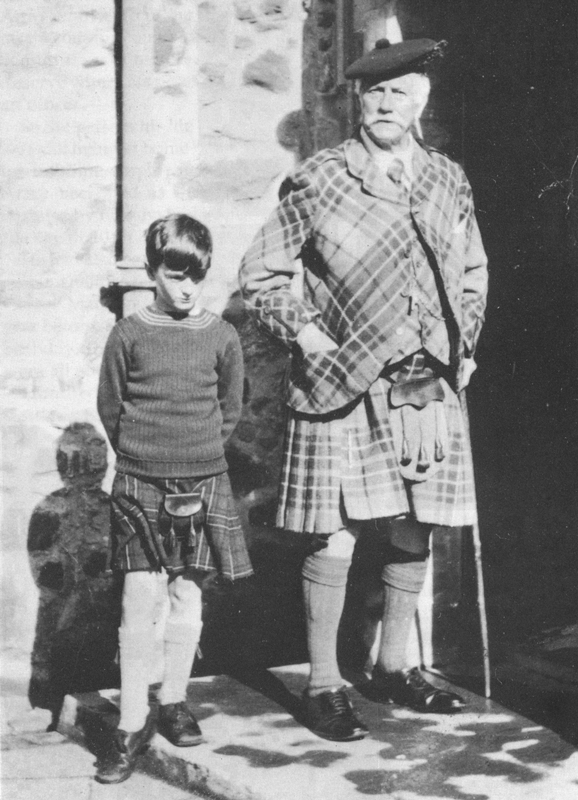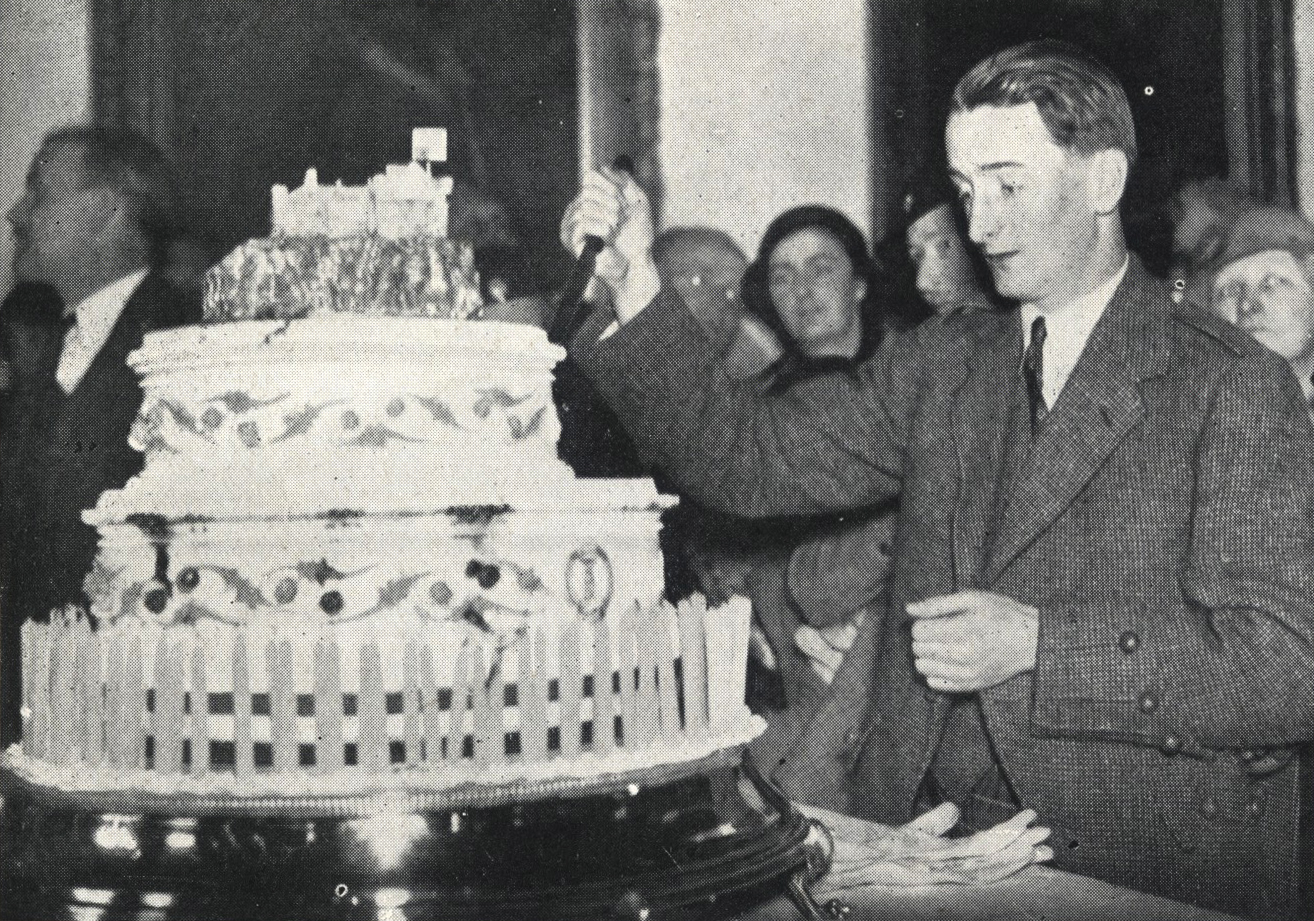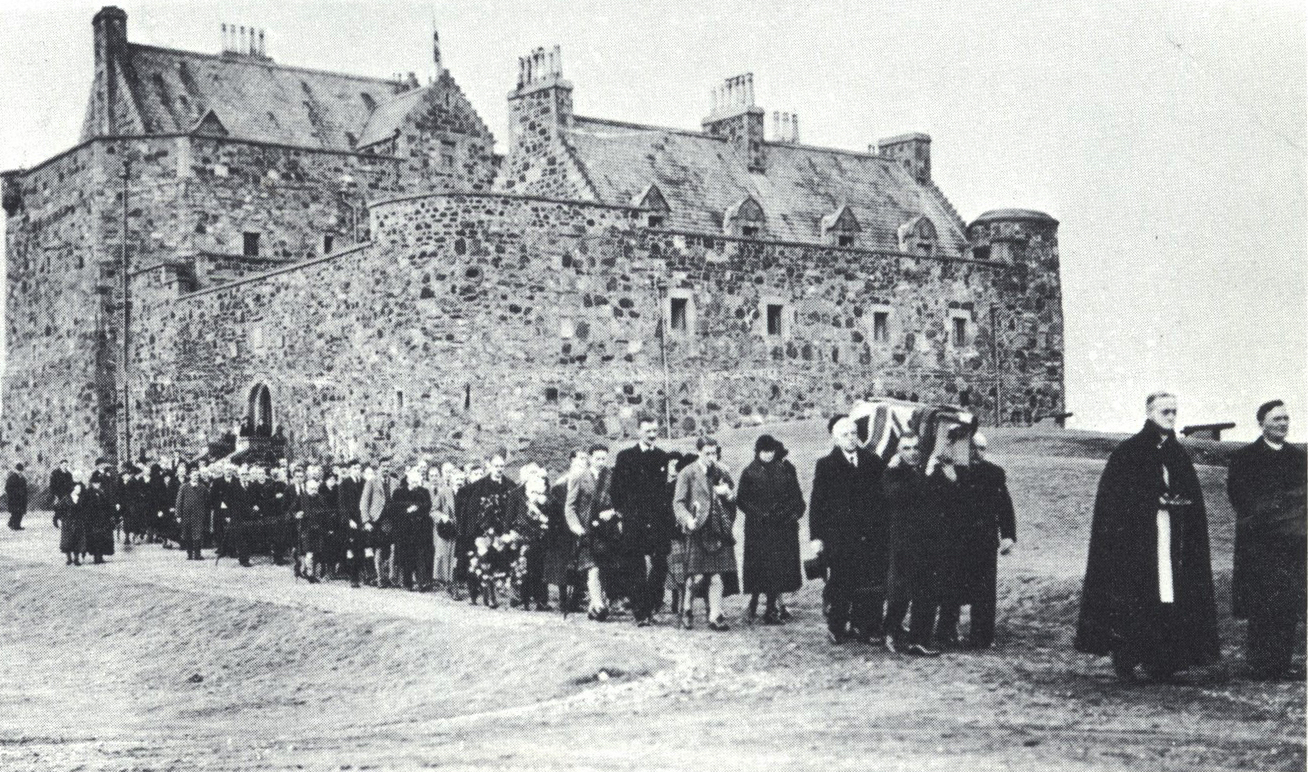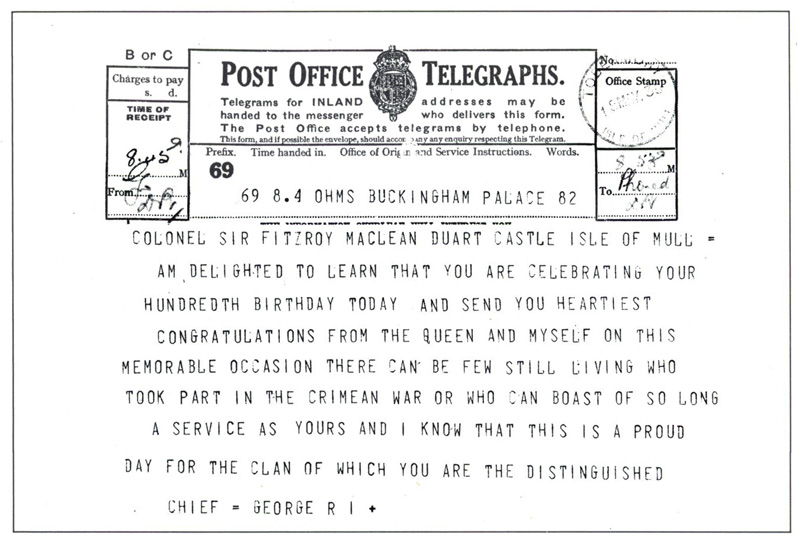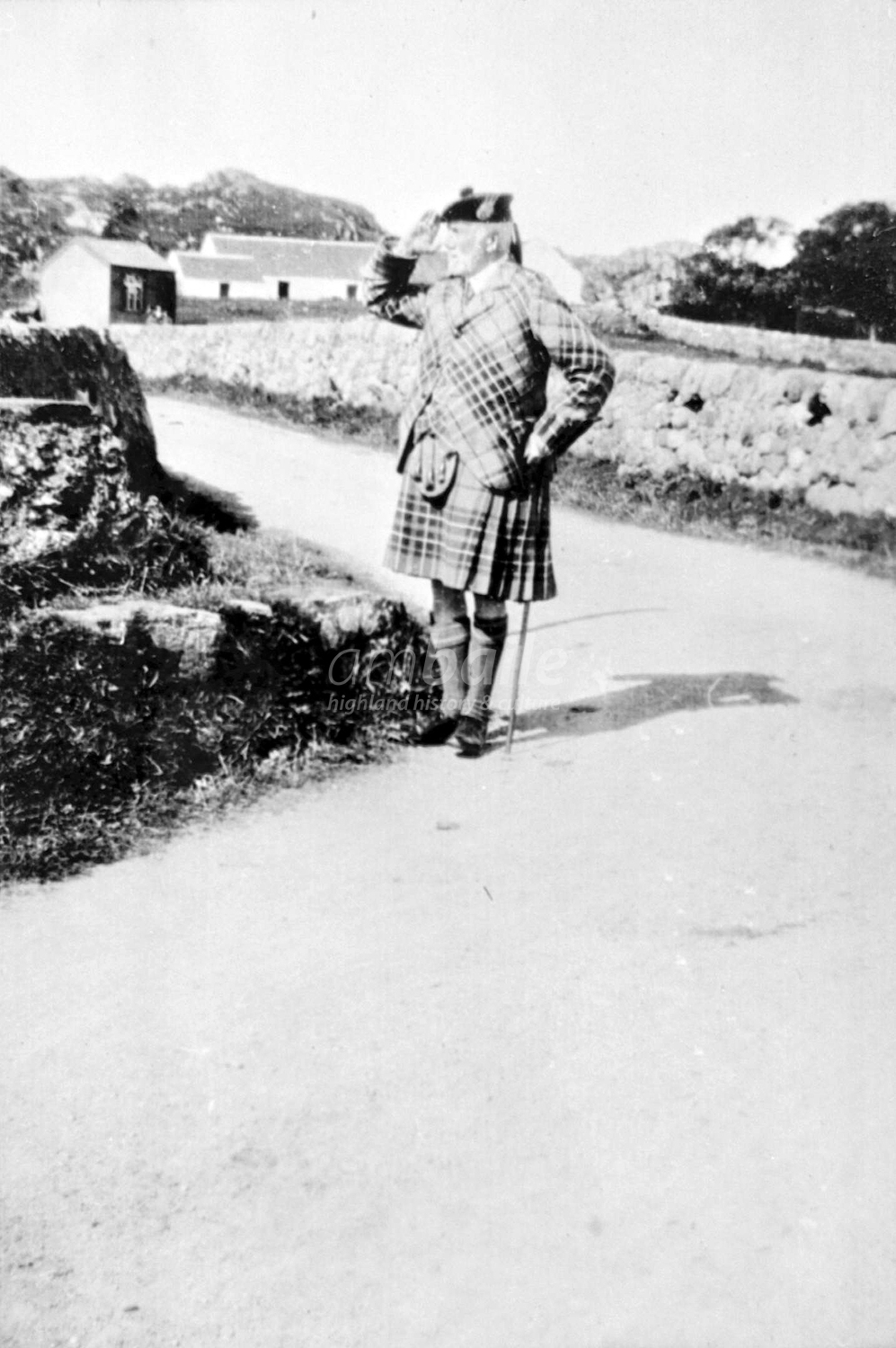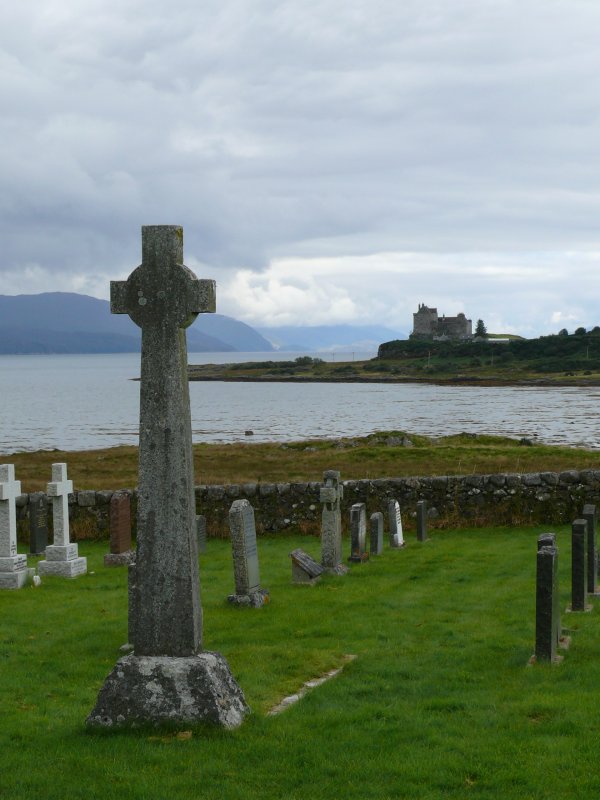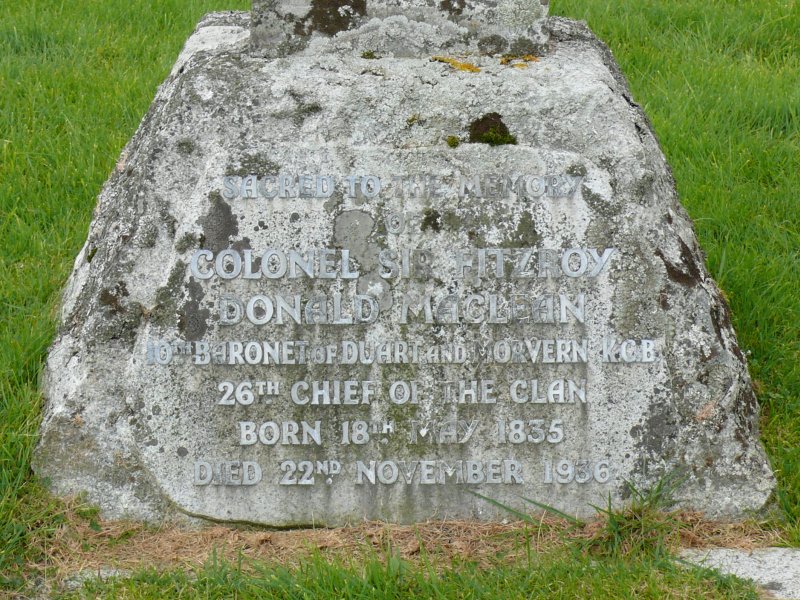26th Chief, 10th Baronet of Morvern, 22nd Laird of Duart, KCB, DL, 6th Lord Maclean*
Colonel Sir Fitzroy Donald Maclean, 10th Baronet of Duart and Morvern, KCB, DL, 6th Lord Maclean* succeeded his father as the 26th Chief of the Clan Maclean on the 27th of December in 1883. Though listed in Black’s 1904 Who’s Who25, Sir Fitzroy will forever be remembered as the man who restored Duart Castle to his clan. Sir Fitzroy embodied the renaissance of the Clan Maclean who’s resurgence owes much to his leadership as its chief.
Sir Fitzroy was a career officer of the British Army2 and a Crimean War veteran.1 He was a tall, lean figure that all remembered as friendly, kind, and outgoing;2 he was a keen sportsman and horseman.2 A well-traveled man, Sir Fitzroy had visited most of the major cities of Europe and had developed friendships around the world.2 He was once received by Pope Pius IX;12 while in Ireland he regularly lunched with the Prince of Wales12 (later King Edward VII) and frequented tea parties attended by Queen Victoria.12 While stationed in Canada Sir Fitzroy even developed a friendship with Jefferson Davis,12 who had been released from prison.
Professor Magnus Maclean recalled at the 1912 gathering, “There have been none who gained more renown in the service of his country than Sir Fitzroy Donald Maclean… when he was created a Knight Commander of the Bath the Royal attendants who were instructing him how to bend the knee and kiss the King’s hand were astonished to see King Edward warmly shaking hands with him before placing the decoration on his breast.“3
Service
1852 Cornet, British Army, 7th Dragoon Guards13
Cornet, British Army, 13th Light Dragoons13
1854 Lieutenant, British Army, 13th Light Dragoons14
1856 Captain, British Army, 13th Light Dragoons15
1858 Aide-de-Camp, Field-Marshal Lord Seaton2
1859 Aide-de-Camp, General Sir George Brown2
1861 Major, British Army8
1871 Lieutenant-Colonel, British Army17
Commanded the 13th Hussars2
1873 Retired, on half-pay18
1875 Major, British Army, West Kent Yeomanry?
1880 Lieutenant Colonel, British Army,
Commanded the West Kent Yeomanry1
1881 Colonel (Honorary), British Army8
1897 President of the Mull and Iona Associaiton24
1899 Resigned commission2
President, Highland Society of London25
1907 President, League of Mercy for Hythe, Kent12
1932 Deputy Lieutenant of Argyllshire22
Honors
1855 Awarded the Crimean Medal1
Awarded the Turkish War Medal1
1883 10th Baronet of Morvern28
6th Lord Maclean9
1897 Companion, Order of the Bath8
1904 Knight Commander, Order of the Bath20
1911 Order of Mercy21
Family
Sir Fitzroy was born in Dublin12 on the 18th of May in 18351 and was the only son of Sir Charles Maclean and Emily Marsham.1 He had four sisters, Emily Frances Harriet, Louisa Marianne, Fanny Henrietta, and Georgina Marcia.1
Though his father was well respected in his own right, the women in Sir Fitzroy’s family expanded the family’s connection to society and influence. Sir Fitzroy’s maternal grandfather was the Hon. Jacob Marsham DD, Canon of Windsor and second son of Robert Marsham, 2nd Baron Romney.1 His brothers in law included the second son of the Earl of Aberfavenny, John Allan Roll, 1st Baron Llangattock of The Hendre, and Admiral Lord Arthur Hood, 1st Baron Hood of Avalon, GCB.1 Sir Fitzroy also had a few notable nephews, John Maclean Rolls, 2nd Baron Llangattock and Charles Rolls co-founder of Rolls Royce.4
On January 17th of 1872 Sir Fitzroy married Constance Marianne Ackers of Moreton Hall in 1872.1 She was the daughter of George Holland Ackers, the High Sheriff of Cheshire.2 The met at a dinner party given by Sir Fitzroy’s sister.12 They had four sons and one daughter—Hector Fitzroy, Charles Lachlan, Fitzroy Holland, John Marsham, and Finovala Marianne Eleanor.2
Sir Fitzroy’s youngest son, John, perished in the Second Boer War while attempting to take a gun position. A young Lieutenant in charge of 32 soldiers, John was wounded eight times before he finally fell.3 Sir Fitzroy once noted, “he behaved as a Maclean ought to behave… he fought bravely for his King and country.“3
Military Service
The military career of Sir Fitzroy began in 1852 when he joined the 7th Dragoon Guards light calvary regiment of the British Army at the rank of Cornet. On October 12th of that same year, he was granted a transfer to the 13th Light Dragoons, the same regiment his father had commanded and retired from as a Colonel 5 years prior. The regiment was renamed the 13th Hussars shortly after Sir Fitzroy joined (though official records continue to refer to them as “Dragoons”).
The son of an officer and well-connected gentleman, young Sir Fitzroy was inescapably aware of the conflict brewing around the Black Sea. The region heaved with turmoil fed by the simultaneous expansion of Russian military power in the Crimea and the harassment of Christian minorities traveling in the Ottoman-controlled Holy Land. Leading up to his 18th birthday in 1852, Sir Fitzroy could not have known that he would not only witness history but would become an active player on the world stage the following years.
In the Crimea
International power shifts in the Black Sea region coincided with the intersection of old-world tactics and modern technological advances. The Crimean War would be the first appearance of modern technologies such as explosive naval shells, railways, telegraphs, photography, and combat nursing practices on the battlefield. Telegraphs and photography brought war to the public as never before while Florence Nightingale pioneered better methods to treat the battle-wounded.
Sir Fitzroy deployed with the 13th Hussars in Bulgaria and the Crimea2 for the full duration of the Crimean War, fighting in every battle they faced with only one exception. Commencing with the landing on the beaches of Calamita Bay in September of 1854 and the subsequent occupation of Eupastoria,2 the Crimean Campaign moved from the south west coast of the Crimean Peninsula south to the Russian fortress at Sevastopol.
Crossing the Alma River was the first major engagement of the war,4 and was preceded by cavalry skirmishes that slowed the Bulganak River crossing; Sir Fitzroy fought in both2 and showed leadership potential.
Although a young subaltern (junior) officer at the time of the Calamita Bay landing, Sir Fitzroy was quickly promoted to Lieutenant the day after the Battle of Alma.7
While en route to the seaport of Balaclava Sir Fitzroy fell ill,3 most likely from dysentery which affected many on the campaign. His illness was bad enough that he was invalided and sent aboard ship to Malta6 days before the Battle of Balaclava. While waiting to sail into Scutari, he met Florence Nightingale.12 This illness may have saved his life. Had Sir Fitzroy been well, he would have certainly participated in Lord Cardigan’s disastrous cavalry charge, immortalized by Tennyson’s poem, “The Charge of the Light Brigade.” Sir Fitzroy was checked into the regimental depot on May 5, 1855.6 Upon recovering he returned to his regiment for the remainder of the year-long Siege of Sevastopol6 which brought and end to the war.2

On the 18th of May in 1855,6 Sir Fitzroy was awarded the Crimean War Medal3 with two clasps directly from the hand of Queen Victoria6 at a ceremony on the Horse Guards Parade.6 He was also awarded the Turkish War Medal.6 Sir Fitzroy presented the charger he rode during the Battle of Balaclava to Queen Victoria when he retired, the mare spent the rest of her days at the mews of Buckingham Palace. When the hourse died, Queen Victoria had its hooves sent to Sir Fitzroy,12 who commissioned a candelabra made from the braid of his uniforms mounted on the hooves, it is known as the Crimean Trophy.12
In France
Sir Fitzroy was fortunate to serve as Aide-de-Camp to both General George Brown and Field Marshal Lord Seaton.2 The connections made while serving with Gen. Brown and FM Seaton seemed to have opened doors for him. Though only a major, Sir Fitzroy attended and reported on French Cavalry maneuvers at Chalons1 for the British Government in 1865.1 He was selected over several more senior officers who desired the appointment because it required frequent conversation with the French emperor, Napoleon III.2
In Canada
From 1866 until 1869 Sir Fitzroy’s regiment, the 13th Hussars, was sent to Canada8 to bolster the military presence there. The Fenian Rising8 in Ireland had spilled across the Atlantic into North America. Irish nationalists dissatisfied with the British governance of Ireland, the Irish Republican Brotherhood (IRB), attempted to overthrow British rule in Ireland.11 Irish immigrants in the Americas, sympathetic to the Fenian cause, organized and executed five raids in Canada.11 The raids proved to be of little effect and the rebellion was ultimately crushed.11
The 13th Hussars were never sent into action while in Canada. During the more than three years they were in Canada, they built permanent troop quarters and converted old cattle sheds into horse stables.8 The primary mission and accomplishment of the 13th Hussars was the establishment of a cavalry school where they trained Canadian mounted volunteers8 and raised the New Brunswick Regiment of Yeomanry Cavalry in 1869.
In great Britain
After the 13th Hussars returned from Canada to Great Britain, Sir Fitzroy was promoted to Lieutenant-Colonel, and in 18722 he was given command of the regiment which his father had commanded. He held command until his own retirement in September of 1873.2 Sir Fitzroy’s retirement was short-lived, and two years later he was recalled to service and given command of Queen’s Own West Kent Yeomanry at the rank of Major to help reform it. As his final retirement approached, Sir Fitzroy was promoted to Colonel (Honorary). In 189919 Sir Fitzroy resigned his commission for good and was granted “
permission to retain his rank and wear the prescribed uniform.“
6
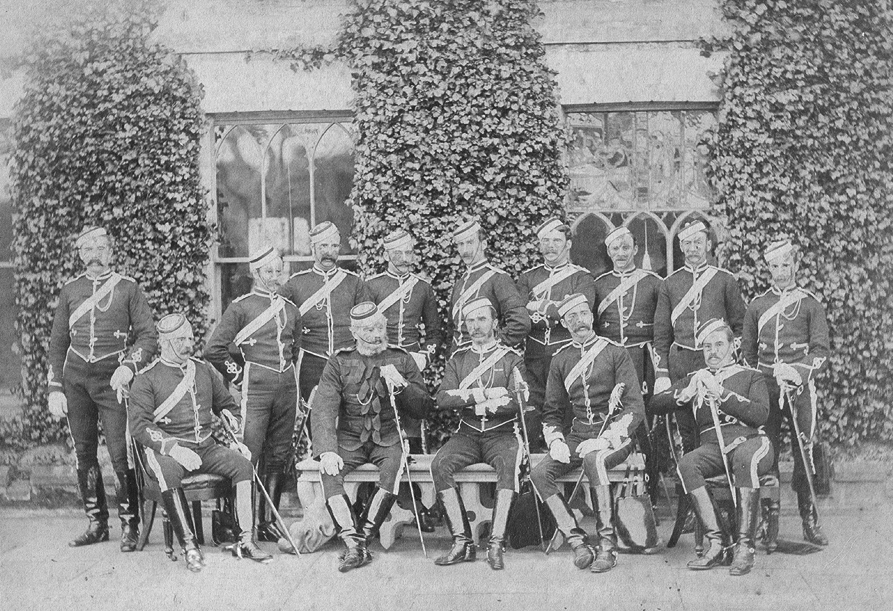
Return to Duart
As a boy in his early teens, Sir Fitzroy was taken to the ruins of Duart Castle by his father, Sir Charles.6 The castle had been put to ruin nearly two centuries earlier by the Campbells at the direction of their chief, Archibald Campbell the 1st Duke of Argyll.5
The young Sir Fitzroy saw the fortress that had been the seat of his clan since 1350 and vowed to reclaim the ancient ancestral home and return it to its former glory.6 Throughout his life, Sir Fitzroy never returned to the old fortress until he could make good on his vow.
During the nearly two centuries Duart Castle lay in ruin, the Campbells had pulled the roof off of the keep and scattered many of the stones of its defensive walls.5 For a short period in 174812 British troops were quartered in the castle. A devastating fire consumed what remained of the castle’s interior and it was abandoned in 1751.5
“I am happy to say the ancient stronghold of the Macleans is now my property.”
Sir Fitzroy27
In 1911,12 Sir Fitzroy redeemed his vow and took position of the Clan’s ancient seat on Mull. Upon repurchasing Duart, he immediately set about restoring the fortress. On the 24th of August in 19123 more than 400 clansmen traveled from across the globe to witness their Chief unfurl his standard over Duart.3 As the banner was hoisted, Sir Fitzroy noted, “It is 221 years since the Maclean banner has been over this ancient castle… and I know perfectly well that the honor of that flag and the honor of our clan will be ever safe in your hands.“3
The End of a Feud
In 1932, Sir Fitzroy marked the occasion of his 100th birthday by planting a rowan tree on the castle grounds. He received messages from 30,000 of his clansmen scattered around the globe;10 among them were two very special telegrams, one a personal note from King George V12 and one from Niall Campbell the 10th Duke of Argyll.3 Thus ended the 187 year old feud between the Macleans and the Campbells.
“My clansmen, I hope you will bear in mind that we must this day bury the hatchet. I have the kindest letters from those who formerly were our enemies, and who, I may now say, are our greatest friends. With your kind permission, I will read a telegram I have just received from the Duke of Argyle. The Duke of Argyle says, “Rejoice with you at Duart.” That is very short, but it is very expressive, and I am sure you will wish me to return the thanks of the Clan to him for his expressions of goodwill towards us.”3 — Sir Fitzroy Maclean
Illustrative of Sir Fitzroy’s wry sense of humor, his reply to the Duke of Argyll read, Certainly, for my lifetime.
12
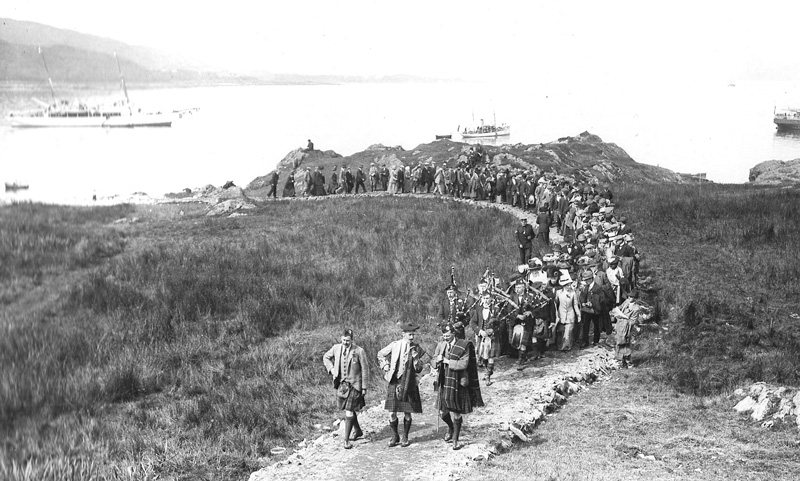
Sir Fitzroy outlived all of his sons. On November 22 of 1936 at age 101, he passed away peacefully in his bed within the walls of the ancient home of his ancestors on the Isle of Mull. Per his wishes, Sir Fitzroy’s remains were laid to rest in the little graveyard of Kilpatrick, looking north toward Duart, the ancient home of his beloved clan.6
Lord Baden Powell a comrade-in-arms from the 13th Hussars wrote an “appreciation” of Sir Fitzroy.6 Sir Fitzroy lived an extraordinary life and not only witnessed history, he played a role in it. Reclaiming Duart sparked a renascence of the Clan Maclean across the diaspora of the ancient clan propelling his descendants to influence little know amount Scottish Chiefs.
As Sir Fitzroy out-lived all four of his sons, the chiefship and baronetcy fell to his grandson, Lord Charles Hector Fitzroy Maclean.
